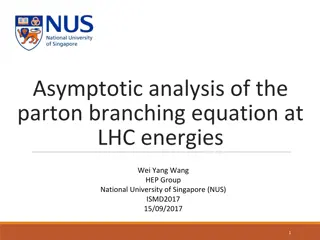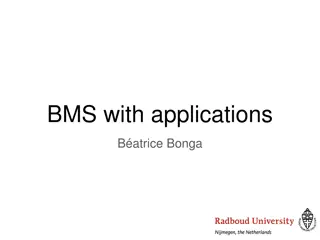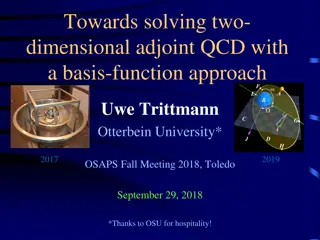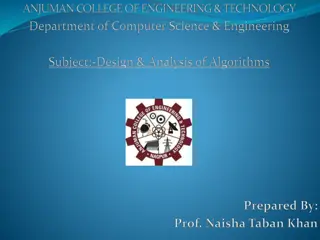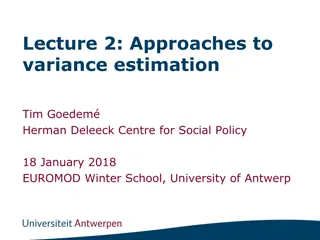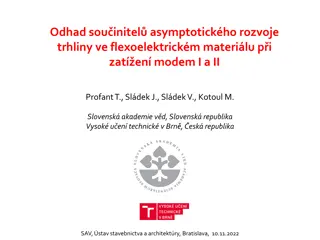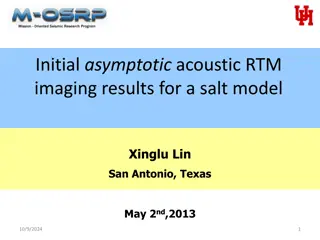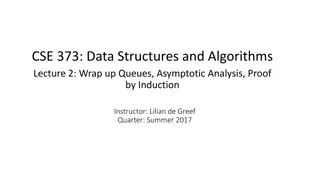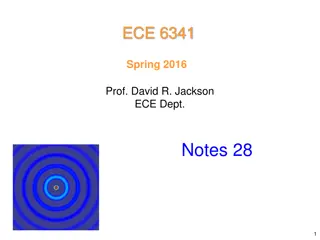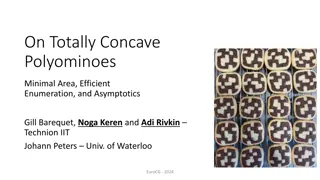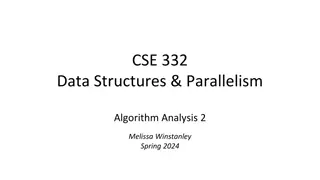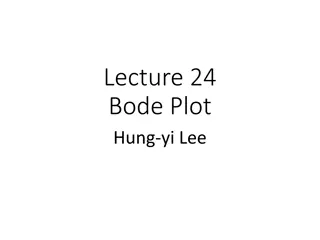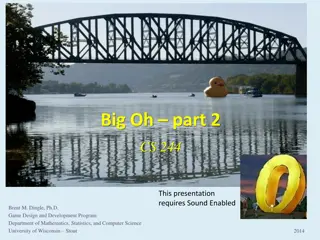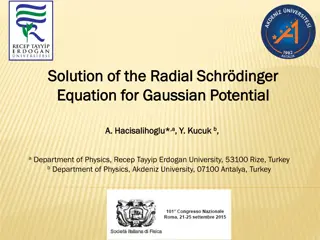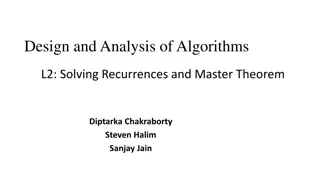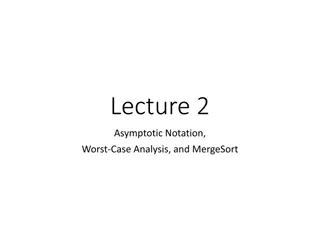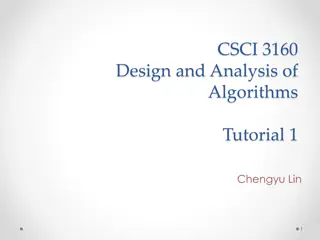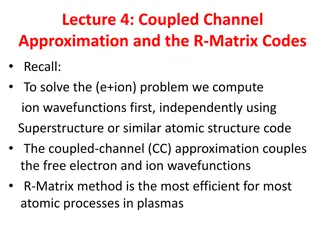Algorithm Analysis
Algorithm analysis involves evaluating the efficiency of algorithms through measures such as time and memory complexity. This analysis helps in comparing different algorithms, understanding how time scales with input size, and predicting performance as input size approaches infinity. Scaling analysi
9 views • 30 slides
Combining Graph Algorithms with Data Structures and Algorithms in CSE 373 by Kasey Champion
In this lecture, Kasey Champion covers a wide range of topics including graph algorithms, data structures, coding projects, and important midterm topics for CSE 373. The lecture emphasizes understanding ADTs, data structures, asymptotic analysis, sorting algorithms, memory management, P vs. NP, heap
4 views • 38 slides
Insights into Parton Branching Equation at LHC Energies
Multiplicity distributions play a crucial role in understanding the cascade of quarks and gluons at the LHC energies, revealing underlying correlations in particle production. Popular models like Monte Carlo and statistical models are used to describe the charged particle multiplicity distributions.
2 views • 17 slides
Asymptotic Structure in Physical Spacetime
Exploring the implications of asymptotic flatness and symmetry in physical spacetime, focusing on concepts like conformal completion, Einstein's equations, and the Bondi-Metzner-Sachs group (BMS) for providing physical interpretations of mass, linear momentum, and angular rotation subgroups.
5 views • 28 slides
Algebraic Solutions for Two-Dimensional Adjoint QCD
Two-dimensional adjoint QCD is explored with a basis-function approach aiming to achieve single-particle states over cluttered multi-particle states. The algebraic solution involves t'Hooft-like integral equations and pseudo-cyclicity considerations to address parton number violation and boundary co
5 views • 22 slides
Observational Constraints on Viable f(R) Gravity Models Analysis
Investigating f(R) gravity models by extending the Einstein-Hilbert action with an arbitrary function f(R). Conditions for viable models include positive gravitational constants, stable cosmological perturbations, asymptotic behavior towards the ΛCDM model, stability of late-time de Sitter point, a
6 views • 12 slides
Comprehensive Course Overview on Algorithm Analysis and Design
Explore a detailed syllabus covering mathematical foundations, complexity calculations, asymptotic analysis, dynamic programming, traversal techniques, and more. Dive into key concepts like recursion, divide and conquer, greedy algorithms, backtracking, and approximation algorithms. Gain insights in
5 views • 11 slides
Evolution of Collisionless Plasma Bounded by Absorbing Walls
Study on the evolution of collisionless plasma between absorbing walls, analyzing rarefaction waves, density profiles, and plasma potential decay. Kinetic simulations reveal gas dynamics-like behavior with flat density profiles and linear velocity profiles leading to asymptotic decay. The influence
1 views • 15 slides
Approaches to Variance Estimation in Social Policy Research
This lecture discusses approaches to estimating sampling variance and confidence intervals in social policy research, covering topics such as total survey error, determinants of sampling variance, analytical approaches, replication-based approaches, and the ultimate cluster method. Various methods a
2 views • 34 slides
Flexoelectric Materials and Their Asymptotic Behavior in Crack Development
Explore the utilization of asymptotic approaches to analyze crack development in flexoelectric materials, considering the influence of intensity of applied stress, limitations, advantages, and the connection to singular perturbation methods. Discover the intriguing property of flexoelectric material
0 views • 17 slides
Initial Asymptotic Acoustic RTM Imaging Results in Salt Model
Acquire insights into the initial asymptotic acoustic RTM imaging results for a salt model in Xinglu Lin, San Antonio. This study delves into the concept of Reverse Time Migration (RTM), showcasing the methodology, workflow, and imaging conditions involved in this innovative seismic imaging techniqu
1 views • 22 slides
CSE 373 Data Structures and Algorithms Lecture Wrap-up: Queues, Asymptotic Analysis, Proof by Induction
In this lecture, we wrapped up discussions on queues, started asymptotic analysis including Big-O notation, and delved into proof by induction. The instructor, Lilian de Greef, covered various topics essential for understanding data structures and algorithms. Additionally, announcements were made re
3 views • 32 slides
Asymptotic Evaluation Techniques in Integral Calculus
Learn about asymptotic evaluation of integrals through techniques like integration by parts and the stationary-phase method. Understand how to handle integrals involving real functions, and grasp the significance of concepts like the Riemann-Lebesgue lemma and small o notation. Delve into the physic
3 views • 21 slides
Efficient Enumeration and Minimal Area of Totally Concave Polyominoes
Researchers present findings on total concavity in polyominoes, exploring the minimal area, efficient enumeration methods, and asymptotic behaviors. Various bounds and algorithms are discussed, including a backtracking prototype and Jensen's algorithm for counting polyominoes without generating all
2 views • 22 slides
Analysis and Comparison of Wave Equation Prediction for Propagating Waves
Initial analysis and comparison of the wave equation and asymptotic prediction of a receiver experiment at depth for one-way propagating waves. The study examines the amplitude and information derived from a wave equation migration algorithm and its asymptotic form. The focus is on the prediction of
0 views • 23 slides
Algorithm Analysis: Comparing Linear and Binary Search
Exploring the nuances of algorithmic analysis, this content delves into comparing linear and binary search algorithms. It discusses the importance of asymptotic analysis, Big-O notation, and the impact of constant factors on algorithm efficiency. Through visual aids and clear explanations, it highli
3 views • 27 slides
Bode Plots in Control Systems
This content explores the concept of Bode plots in control systems, covering topics such as drawing Bode plots, asymptotic lines, magnitude calculations, and more. It includes helpful resources, references, and examples to enhance your understanding of Bode plots and their significance in system ana
0 views • 55 slides
Big-Oh in Algorithms: More on Efficiency and Complexity
Today's presentation covers more advanced concepts of Big-Oh notation beyond Chapter 1. Understanding linear and binary search algorithms, their efficiency, and how to apply them in code. Dive into the math and code aspects of asymptotic analysis with practical examples.
0 views • 140 slides
Radial Schrödinger Equation Solution for Gaussian Potential
Energy eigenvalues and eigenfunctions in quantum mechanics are studied through the exact solution of the radial Schrödinger equation for Gaussian potentials, using the Asymptotic Iteration Method. The method's efficiency in solving wave equations for different potentials is highlighted, with a focu
2 views • 23 slides
Limits and Algorithms in Network Science
This section delves into the complexities of modularity and optimized greedy algorithms for community detection in network science. It covers topics such as asymptotic resolution bounds, modularity measures, the greedy algorithm process, the resolution parameter, plateau problems, and multi-scale co
0 views • 17 slides
Introduction to Analysis of Algorithms
Analysis of Algorithms involves determining the efficiency of algorithms by computing the time needed to solve a problem. Time complexity is a key factor, denoted by functions like t(n) or f(n), where n represents the input size. Asymptotic Growth focuses on the behavior of time complexity for large
6 views • 26 slides
Exponential Growth and Decay Models Exploration
Examine various exponential functions in real-life scenarios, understanding their shapes, properties, and asymptotes. Learn to identify key parameters like y-intercept, growth rate, and asymptotic lines.
0 views • 25 slides
Asymptotic Series: Properties and Notations
Asymptotic series play a crucial role in analyzing functions as their magnitude grows. Explore the properties and notations of asymptotic series, including Big O and Small o notations. Learn how these series show the behavior of functions as their input values increase.
2 views • 39 slides
Bode Plots for System Analysis
Learn about Bode plots for analyzing system dynamics, including drawing magnitude and phase plots, understanding asymptotic lines, and interpreting real pole effects. Explore resources for creating Bode plots using MATLAB and Wolfram Alpha.
5 views • 55 slides
Solving Recurrences and Master Theorem in Algorithm Analysis
Dive into the world of algorithm analysis with a focus on solving recurrences and mastering the theorem. Learn about asymptotic analysis, merge sort examples, and recurrence equations in this comprehensive guide. Explore how to analyze the running time of algorithms and gain insights into optimizing
3 views • 54 slides
Formal Definition of Asymptotic Notation: t(n) ∈ O(g(n))
Delve into the precise, formal definition of t(n) being in O(g(n)), a fundamental concept in analyzing algorithmic efficiency and growth rates. Learn how to identify and compare functions in asymptotic notation.
0 views • 27 slides
Asymptotic Behavior in Algorithms
Explore the concept of asymptotic behavior in algorithms, focusing on Big-O notation, complexity analysis, and algorithm performance scalability as input size grows. Discover how to evaluate algorithmic cost functions independently of specific hardware or implementation details.
2 views • 39 slides
Optimizing Algorithm Efficiency Through Asymptotic Notation and Sort Complexity
Explore concepts of asymptotic notation, worst-case analysis, and MergeSort in computer science. Get ready for the upcoming midterm, ACE section, homework releases, and office hours. Learn about sorting algorithms and their impact on performance.
0 views • 86 slides
Algorithm Complexity Analysis
Explore the fundamental concepts of algorithm analysis, including time complexity, space complexity, asymptotic analysis, operation counting, best-case, worst-case, and average-case scenarios. Dive into scaling analysis to understand the growth rate of functions and the significance of constant mult
0 views • 35 slides
Design and Analysis of Algorithms Tutorial with Chengyu Lin
Explore asymptotic notations, time and space complexity analysis, and Big O notation in the context of algorithm design and analysis. Understand how to analyze running time complexities of programs, simplify calculations, and determine upper bounds for algorithm efficiency. Learn from Chengyu Lin's
2 views • 30 slides
Asymptotic Notations in Algorithms
Learn about major asymptotic notations like Big-O, Big-Omega, Theta, small-o, small-omega, and how they are used to analyze the running time of algorithms based on different growth rates. Explore practical examples and comparisons to enhance your understanding.
3 views • 18 slides
Asymptotic Notations for Algorithm Complexity Analysis
Learn about asymptotic notations such as Big Theta, Big O, and Big Omega to analyze the running time of algorithms in relation to input size. Explore how these notations describe the rate of growth of functions and establish bounds for algorithm efficiency.
3 views • 36 slides
Quantum State Tomography: Optimal Methods and Bounds
Explore sample-optimal tomography of quantum states, minimizing loss and maximizing classical descriptions. Learn about the necessary/sufficient number of copies, boundary cases, and local asymptotic normality. Dive into optimal measurements, symmetry determinations, related work, and lower bounds i
4 views • 16 slides
Efficient Atomic Process Modeling with Coupled-Channel Approximation
Explore the efficient use of the coupled-channel approximation and R-Matrix method in solving electron-ion interactions, from computing ion wavefunctions to diagonalization of the Hamiltonian for various atomic processes in plasmas. Dive into the stages and flow chart of R-Matrix codes, as well as t
4 views • 5 slides
Examples of Steady Flow Phenomena in Physics and Asymptotic Processes
Explore examples of steady flow phenomena in physics involving Ohm's law, Fourier's law, and more. Discover how processes approach end points asymptotically, such as in radioactive decay and cooling of objects. Gain insights into modeling and solving these phenomena.
0 views • 9 slides
Understanding Newton's Multivariate Method
Explore the multivariate version of Newton's method, a generalization of the univariate version, and learn about the iterative procedure's estimation of asymptotic variance-covariance matrix. Discover how the maximum likelihood estimator becomes asymptotically normal under certain conditions.
1 views • 5 slides
Understanding Asymptotic Behavior in Algorithms
Dive into the concept of asymptotic behavior in algorithms and data structures through examples and methods. Learn why it matters and how to analyze functions as input size approaches infinity, shedding light on the importance of asymptotic analysis for algorithm efficiency.
1 views • 42 slides
Flexoelectric Solid Asymptotic Analysis
Explore the asymptotic development of cracks in flexoelectric materials under mechanical loads and the potential use of intensity factors in linear elastic fracture mechanics. Understand the flexoelectric effect and the inner and outer asymptotic energies for crack development. Discover the properti
2 views • 17 slides
Understanding Algorithm Complexity Through Asymptotic Analysis
Dive into the world of algorithm complexity analysis with a focus on asymptotic notation and finding the asymptotic upper bound of algorithms. Learn how to measure algorithms, compare them, and grasp the significance of resource functions in determining algorithm efficiency.
1 views • 60 slides
Understanding Asymptotic Notations
Learn about Big-O, Big-Omega, Theta, small-o, and small-omega notations in the context of analyzing algorithm efficiency. From defining the notations to understanding relationships between different functions, explore the world of asymptotic notations visually explained with examples.
1 views • 18 slides


